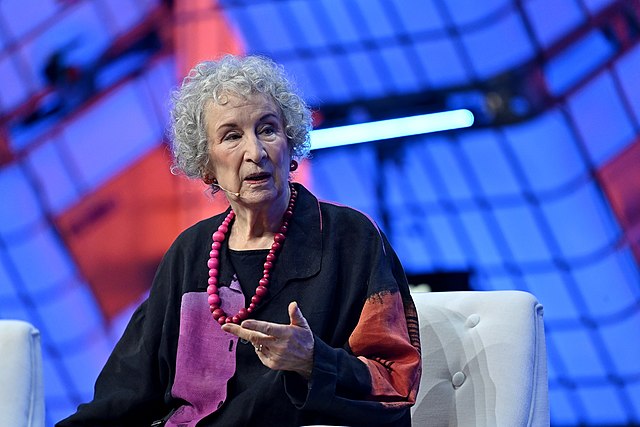
News
Progressive Labor Party Organizes Solidarity March With Harvard Yard Encampment

News
Encampment Protesters Briefly Raise 3 Palestinian Flags Over Harvard Yard

News
Mayor Wu Cancels Harvard Event After Affinity Groups Withdraw Over Emerson Encampment Police Response

News
Harvard Yard To Remain Indefinitely Closed Amid Encampment

News
HUPD Chief Says Harvard Yard Encampment is Peaceful, Defends Students’ Right to Protest
Artist Profile: Margaret Atwood, from a Lump of Clay to ‘Old Babes in the Wood’

Award-winning author Margaret Atwood, best known for her dystopian novel “The Handmaid’s Tale,” is celebrated internationally for her dozens of works spanning literary forms. Her highly-anticipated, recently released book “Old Babes in the Wood” explores the shared human experiences of family, relationships, loss, and memory through fifteen gripping short stories.
Atwood sat down in conversation with The Harvard Crimson to discuss “Old Babes in the Wood,” her writing process, and how the two relate: she wrote the book to her own taste, and it worked.
When prompted to describe her new book in just a few words, Atwood first said, “a bunch of short stories” — both earnestly and in jest. Upon further thought, she said, “Jokes, griefs, snails, aliens, murders, World War II, and more.” Both of these cryptic descriptions brilliantly highlight the collection as a whole: It is a series of varied stories about varied characters who, while seemingly disconnected ,still thread together with concurrent levity and heaviness.
A married couple, Nell and Tig, serve as the collection’s home — where the collection begins and ends,and where its heart resides — but the couple harmonizes with a multitude of other characters (including a snail in a woman’s body, a young girl raised by a witch, an emergency aid alien, and the ghost of George Orwell) who render the book all the more real.
Atwood described “Old Babes in the Wood” as “an ongoing process, a continuous process.” She explained that writing the book was like pottery: she started with a “lump of clay” and shaped it as it developed, not necessarily with specific inspiration for start or end points. Accordingly, her favorite story in the collection was whichever one she worked on at a given moment.
“The inspiration emerges from the work as you’re doing it,” she said.
Atwood emphasized that no specific idea or incident sparked her to create “Old Babes in the Wood.” She sat down; she wrote. She paid attention to the present and nurtured her art as she moved along with it, a style present in both her writing and speaking. As she spoke, her voice was thoughtful and pensive; her words grew from each other and carried weighty pauses in between.
Despite the broad range of stories in the collection — from “Widows,” a story about grief, to “Metempsychosis,” a story about a woman who believes she is a snail — the stories in “Old Babes in the Wood” are clearly not random.
“There are a lot of people who are going to read the story called ‘Widows’ and know exactly what it is all about,” Atwood said. “Fewer will read the story called ‘Metempsychosis’ and identify with thinking they’re a snail.”
Then, why a snail? Atwood said she wrote about snails because she is “keen on them,” but then she revealed more: they are easier to observe than birds because “they don’t move very fast.”
“Old Babes in the Wood” did not come to Atwood; instead, Atwood came to “Old Babes in the Wood.” She wrote what made sense to her when her mind was in the story. Then, she found what convinced her, what held her attention.
“If it doesn’t hold my attention, it certainly isn’t going to hold anyone else’s,” she said.
Consequently, she was not concerned with the relevance of the book to the reader, or why a reader might want to read it at a given moment.
“That’s a question for a reader to answer,” she said.
It’s a busy moment for Atwood. She brought up the recent ban of “The Handmaid’s Tale” in Madison County, Virginia schools, saying that this is “not [her] first rodeo being banned.” Returning to her alma mater (Radcliffe College, which later merged with Harvard College) to discuss her new book, she mentioned the memory of discovering witchcraft and demonology books in Widener Library as a student because women were not permitted in Lamont Library at the time. With these two topical examples in mind, it is understandable that she would focus her writing toward convincing herself instead of worrying about audience reception. She writes what works, and she writes for herself: a straightforward process.
“Writing is fairly simple,” Atwood said. Even still, “Old Babes in the Wood” is wonderfully complex.
—Staff writer Vivienne N. Germain can be reached at vivienne.germain@thecrimson.com.
Want to keep up with breaking news? Subscribe to our email newsletter.
